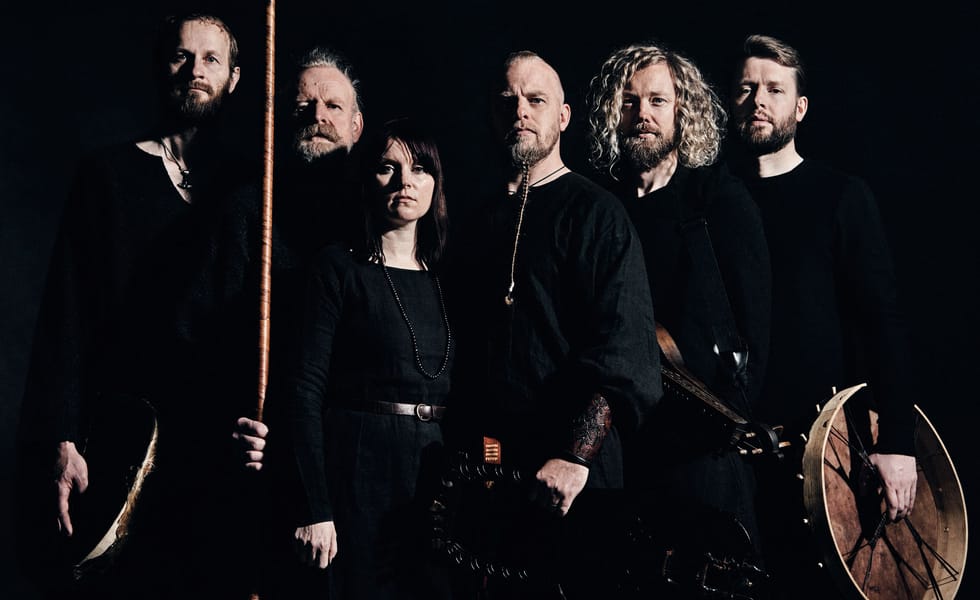For the casual observer, a group of long haired, robed Norsemen playing goat horns, willow flutes, chorded zithers and all manner of other medieval folk instruments is the kind of thing that you would expect to see at a one-off historical fair (usually in a fairly isolated part of town).
To then see the above rendition of a band ink a record deal with Sony Music and continue to grow their huge fan base around the world would no doubt come as a surprise to many.
But for those who have been in the know about Wardruna, the Norse folk classical phenomenon led by composer Einar Selvik, the success of the group, and ultimately their chance to release music through a major label, has been a long time coming.
“We have a very travelling audience – the first time we played in a medieval hall in Norway, there were people who came from Australia to see the concert. It hasn’t felt strange at all to have people from all over the world take interest,” says Selvik, speaking from his studio in Norway about the growing profile of the group.
“There’s people of all ages, ethnicities, from all different subcultures. It’s very cool to see how it all resonates and crosses these cultural borders…One of the reasons that this has happened is that I’ve been very patient. I’ve been true to the art and I’ve waited for the right opportunities to come along as opposed to jumping on everything that came along; that’s the philosophy that has worked.”
Despite Wardruna fitting into a very (very) niche corner of the music world, millions of people are acquainted with the music of Selvik, who’s compositional resume includes the soundtrack for Assassin’s Creed Valhalla and Netflix sensation Vikings.
Additionally, he also held the drumchair for black metal overlords Gorgoroth for a time, going so far down the occult road that he was the focus of this famous photo that, for many, defines the black metal subculture.
“I grew up with both classical and metal music in my house. The division of those two has always been there for me,” he says.
“In terms of Gorgoroth, at that point I was already done on a personal level with the metal thing. That was more of a professional, artistic expression in a way, the need to do something that was more in line with my own passions and interests was increasingly growing.
“I started working on Wardruna alongside Gorgoroth and at some point I just felt that I needed to stop doing everything else and dedicate myself to music that truly meant something to me.
“If you don’t put a price on your art then no one else is going to. Focusing on integrity is a bit underestimated. A lot of artists can be tempted, myself included, by opportunity and hype. But staying true to the original idea and going with the flow, if you can, is the smartest way of doing it.”
It might have been a gamble at the time – going from one of the most hyped black metal acts of the ’90s to entering the classical world, dominated by an audience that holds on tight to the symphonies of centuries gone past – but it’s one that has paid off both professionally and artistically for Selvik.
“I’m picky when it comes to what I work on, because I have to both do a good job, but also have it resonate with my artistic vision,” says Selvik on his creative process.
“With the Assassin’s Creed thing, it was very evident from the start that their vision matched my own vision.
“You’re a vessel when you do that kind of work. You don’t have as much of a say. But for that game, they really shared my vision. We didn’t have any really different views on how it should be or sound.
“Vikings was more of a give and take process though. Firstly, my work there was a collaboration, which in itself is a give and take process, plus the tempo is so high, so you can’t really dwell on it…You have to pick your battles very carefully.”
With a new record due out in 2021, we close our interview by asking Selvik if he’s noticed more of an appetite for Norse culture in the musical world, noting the success of artists like Enslaved, Myrkur and Sólstafir.
“Music is a very powerful tool to provide a contact, or a gateway to something more spiritual, something bigger,” he notes.
“When it comes to pre-Christian cultures, in the North we kept our traditions for a longer time than the rest of Europe did. So, we got to cultivate our traditions more, and when that ‘conversion’ came it wasn’t a grassroots movement – it came from the elite. That means that people now are doing what they’ve always been doing for thousands of years.
“For many people, they see this interest in the Norse being a gateway into their own pre-Christian culture. When you go far enough back in time you see how similar so many cultures and mythologies are.”
Whatever the case, there’s no denying the hypnotic magic of the music Selvik creates, which is bound to continue to draw more people under its spell in the coming months.










